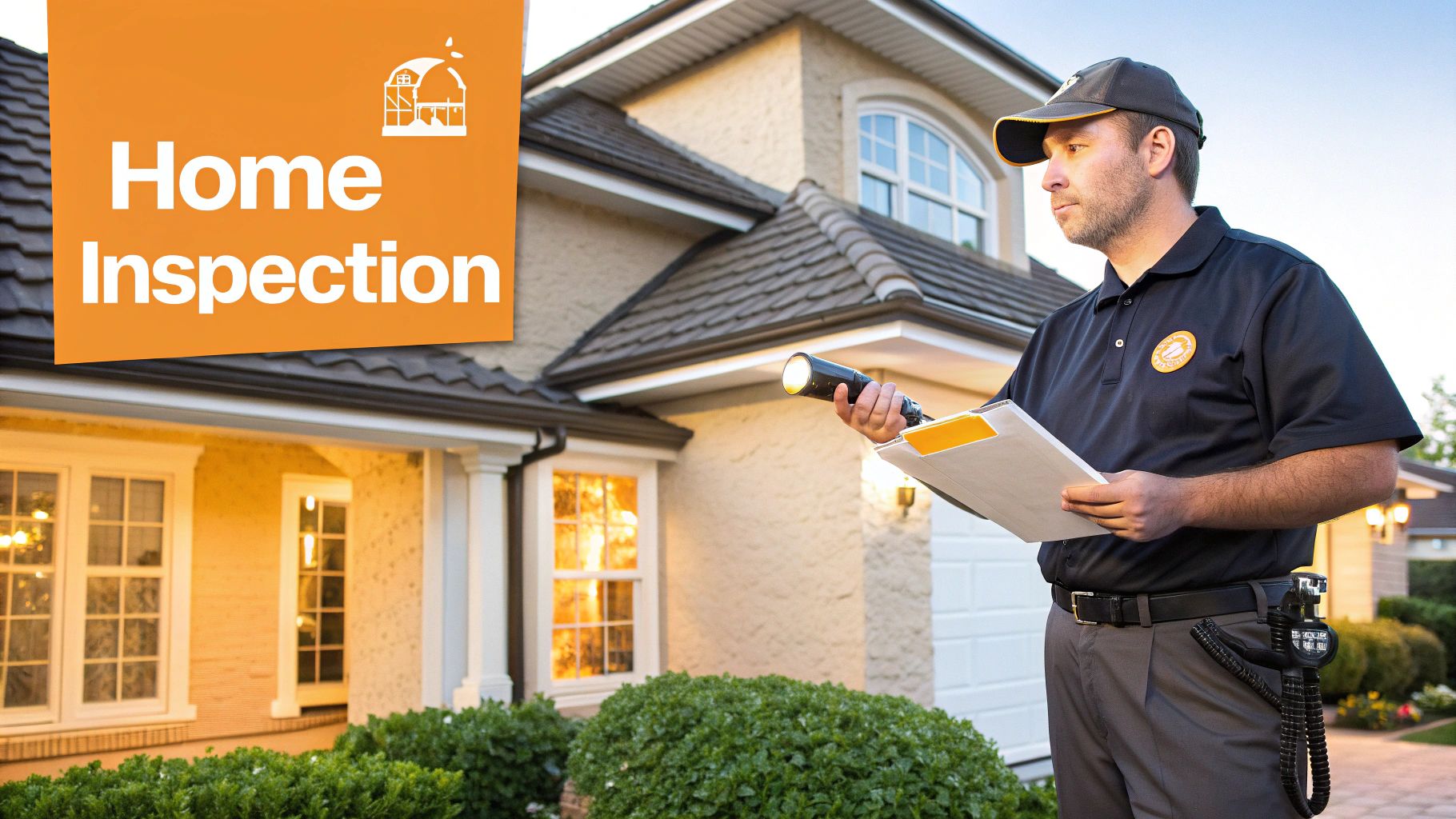Buying your first home is one of life's most exciting milestones, but it can also feel overwhelming. From securing financing to understanding the legalities, the process is laden with critical steps that demand careful attention. This comprehensive checklist for a first home is designed to demystify the entire journey, providing a clear, actionable roadmap for 2025. We'll break down the eight most essential stages, offering detailed insights, practical examples, and expert tips to empower you to make informed decisions with confidence. Think of this not just as a list, but as your strategic guide to navigating the complexities of the property market.
Whether you are just beginning to save or are ready to make an offer, this guide will ensure you manage every phase of the process like a seasoned pro. By following these steps, you can turn the dream of homeownership into a well-planned reality, avoiding common pitfalls along the way. To help you navigate the entire process, refer to our comprehensive guide on the essential steps to buying a house. This resource will provide an even broader overview, complementing the detailed checklist we are about to explore.
1. Pre-approval for Mortgage Financing
The very first step on any aspiring homeowner's checklist for a first home should be securing mortgage pre-approval. This is a crucial process where a lender thoroughly assesses your financial health, including your income, credit history, and existing debts. Based on this evaluation, they provide a conditional commitment for a specific loan amount, effectively telling you how much you can afford to borrow.
Having this pre-approval in hand transforms you from a casual house hunter into a serious, credible buyer in the eyes of estate agents and sellers. It demonstrates that you have the financial backing to complete a purchase, giving you a significant competitive advantage.
Understanding Your Loan Options
Different buyers will suit different mortgage products. It’s vital to explore which type aligns with your financial situation:
- First-Time Buyer Mortgages: Often come with incentives like lower deposit requirements, sometimes as low as 5%, and government-backed schemes like the Mortgage Guarantee Scheme.
- Conventional Mortgages: Typically require larger deposits, often 10% or more. A larger deposit usually unlocks better interest rates.
- Specialist Mortgages: Products like guarantor mortgages or joint-borrower-sole-proprietor mortgages can help those with lower incomes or less-than-perfect credit secure a loan.
Key Insight: Being pre-approved for a specific amount doesn’t mean you should borrow the maximum. Factoring in solicitor fees, stamp duty, and moving costs is essential for a realistic budget.
Actionable Tips for a Smooth Pre-approval
To navigate the pre-approval process effectively, keep these strategies in mind:
- Shop Around: Compare offers from multiple lenders, including high street banks like Lloyds or Barclays and online-only lenders. Do this within a 14 to 45-day window to minimise the impact on your credit score, as multiple credit checks in a short period are often treated as a single enquiry.
- Maintain Financial Stability: Once you start the process, avoid any significant financial changes. This means no new car loans, credit card applications, or job changes if possible, as these can affect your final approval.
- Prepare Your Paperwork: Organise your documents in advance. Lenders will require recent payslips, bank statements, proof of identity, and details of any existing debts. Having everything ready will speed up the process considerably.
2. Professional Home Inspection
Once your offer on a property has been accepted, scheduling a professional home inspection is a non-negotiable next step on your checklist for a first home. This involves hiring a qualified surveyor to conduct a thorough evaluation of the property's condition, from the roof and foundations to the plumbing and electrical systems. This assessment is designed to uncover any hidden defects or potential future problems that aren't visible during a standard viewing.
The surveyor's report provides you with critical leverage. For example, discovering that an older home requires £10,000 in electrical rewiring or that the roof has only a few years of life left can be used to renegotiate the asking price or request that the seller completes the repairs before the sale is finalised. It protects you from costly surprises after you've moved in.
Understanding Different Survey Levels
In the UK, property surveys come in different levels of detail, and choosing the right one is crucial:
- RICS Home Survey – Level 1 (Condition Report): The most basic and cheapest option, suitable for new-builds and conventional homes in good condition. It uses a traffic light system to rate the property’s condition but doesn’t provide detailed advice or valuations.
- RICS Home Survey – Level 2 (HomeBuyer Report): A more detailed survey ideal for conventional properties in a reasonable state. It highlights urgent issues that could affect the property's value and includes a market valuation.
- RICS Home Survey – Level 3 (Building Survey): The most comprehensive survey. It's essential for older, larger, or unconventional properties, or if you plan significant renovations. It provides a detailed analysis of the property's structure and condition.
Key Insight: The cost of a detailed survey may seem high, but it can save you thousands in the long run by identifying major issues before you are legally committed to the purchase.
Actionable Tips for a Successful Inspection
To get the most value from your home inspection, consider these practical steps:
- Attend the Inspection: If the surveyor allows it, attend the final part of the inspection. This gives you a chance to see issues firsthand and ask questions, helping you better understand the property's systems and maintenance needs.
- Focus on Major Systems: Don't get bogged down by cosmetic flaws like peeling paint. Concentrate the surveyor's and your own attention on the big-ticket items: the roof, boiler, electrics, plumbing, and structural integrity.
- Get Quotes for Repairs: If the report flags significant issues, obtain quotes from qualified tradespeople. This provides concrete evidence to support any renegotiation of the sale price with the seller.
- Consider Specialist Inspections: If the property has specific features like a septic tank, a swimming pool, or is in an area known for damp or pest issues, it may be wise to commission a separate, specialist inspection for these elements.
3. Neighborhood Research and Location Analysis
Beyond the four walls of your potential new house, the surrounding neighbourhood plays a monumental role in your daily life and long-term satisfaction. Comprehensive location analysis is a critical part of the checklist for a first home, involving a deep dive into the area’s character, amenities, safety, and future prospects to ensure it aligns with your lifestyle and investment goals.
A property's value is intrinsically linked to its location. Thorough research helps you avoid unpleasant surprises, like discovering a major construction project planned next door, and instead positions you to benefit from positive developments, such as new transport links or regeneration schemes.
Evaluating Key Location Factors
Different factors will matter more to different buyers. It’s crucial to prioritise what is most important for your circumstances:
- Amenities and Lifestyle: Assess the proximity and quality of supermarkets, parks, pubs, and cafes. For families, the catchment areas and Ofsted ratings of local schools are paramount.
- Transport and Commute: Consider your daily journey to work. Check for reliable public transport links like train stations or bus routes and assess traffic conditions during peak hours.
- Safety and Community: Use online resources like Police.uk for local crime statistics. Visiting the area and speaking to residents can provide a feel for the community spirit. For an in-depth look at a specific area, exploring a location guide can offer valuable insights into its benefits, such as why Reading is a great place to move to.
Key Insight: A home’s price might seem like a bargain, but if the location doesn’t meet your needs, the hidden costs in time, stress, or future resale value can be significant.
Actionable Tips for Effective Neighbourhood Research
To build a complete picture of a potential neighbourhood, employ a hands-on approach:
- Visit at Different Times: Experience the area not just on a quiet Sunday afternoon but also during a weekday morning rush hour and on a Friday night. This reveals the true noise levels, parking availability, and general atmosphere.
- Consult Local Plans: Check the local council's website for planning applications and long-term development plans. This will inform you about future construction, new infrastructure, or changes that could impact property values.
- Use Digital Tools: Websites like Walk Score can rate an address based on walkability to amenities. Similarly, property portals like Rightmove and Zoopla often provide school ratings and local data alongside their listings.
4. Down Payment and Closing Costs Planning
Beyond mortgage pre-approval, the next critical financial milestone in any checklist for a first home is planning for your down payment and closing costs. This involves strategically accumulating the significant upfront capital required to secure your property. These funds cover not only the initial deposit on the home but also a range of associated fees that are essential to completing the transaction.
A well-planned savings strategy is paramount. It ensures you are not just prepared for the purchase price but also for the additional expenses like solicitor fees, survey costs, and potential Stamp Duty. Demonstrating that you have these funds readily available reinforces your credibility as a buyer and helps prevent last-minute financial stress.
Navigating Your Deposit and Associated Costs
Understanding the different deposit requirements and additional costs is key to setting a realistic savings target. Your circumstances will largely dictate the best path forward.
- First-Time Buyer Mortgages: Many lenders offer products requiring as little as a 5% deposit. Government initiatives like the Mortgage Guarantee Scheme are designed to support buyers with smaller deposits.
- Conventional Mortgages: A deposit of 10% or more is common. A larger deposit, particularly one approaching 20%, often gives you access to more competitive interest rates and lower monthly repayments.
- Closing Costs: These are separate from your deposit and typically amount to 2-5% of the property's purchase price. They cover legal fees, mortgage arrangement fees, valuation costs, and other administrative charges.
Key Insight: Your savings goal should extend beyond the minimum deposit. Aim to have enough to cover all closing costs, moving expenses, and an emergency fund of 3-6 months' living expenses for after you move in.
Actionable Tips for Financial Preparation
To effectively build your home-buying fund, consider these focused strategies:
- Research Assistance Programmes: Investigate government schemes and local authority programmes designed to help first-time buyers. These can offer significant financial support and make homeownership more accessible.
- Automate Your Savings: Set up a standing order to transfer a fixed amount into a dedicated high-interest savings account or Lifetime ISA (LISA) each payday. This "pay yourself first" approach builds your fund consistently.
- Create a Detailed Budget: Track your income and expenses meticulously to identify areas where you can cut back. Redirecting money from non-essential spending, like daily coffees or subscriptions, can accelerate your savings.
5. Real Estate Agent Selection and Representation
Once you have your mortgage pre-approval, the next logical step in your checklist for a first home is choosing a qualified estate agent. While you can search for properties yourself, a dedicated buyer's agent is a professional who represents your interests, providing market expertise, negotiation skills, and guidance through what can be a very complex transaction. They are legally obligated to work on your behalf, not the seller's.
A great agent can be the difference between a stressful ordeal and a smooth purchase. Their value is often seen in their professional network, which can connect you with reliable solicitors and surveyors, and their ability to find properties before they are even listed on major portals like Rightmove or Zoopla.
What to Look for in an Agent
Choosing the right professional is about more than just finding someone to show you homes. You are hiring an expert to advocate for you.
- Local Expertise: An agent with a proven track record of recent sales in your target neighbourhoods will have invaluable insight into fair market prices and local trends.
- Strong Negotiation Skills: A skilled negotiator can make a huge financial difference, for instance, by successfully arguing for thousands of pounds in seller concessions for needed repairs.
- Proactive Communication: The best agents are responsive, keep you informed at every stage, and manage your expectations clearly from the outset.
Key Insight: Avoid dual agency situations where one agent represents both you and the seller. This creates a conflict of interest, as the agent cannot fully advocate for your best interests while also being obligated to get the highest price for the seller.
Actionable Tips for Selecting Your Agent
To ensure you find a professional who is the right fit, take a methodical approach to your selection process:
- Interview Multiple Candidates: Don't just go with the first agent you meet. Interview at least three different agents to compare their experience, strategy, and personality. Ask for references from recent clients.
- Check Credentials and Reviews: Verify their qualifications and look for accreditations from bodies like Propertymark. Read online reviews to gauge past client satisfaction.
- Clarify Your Agreement: Before committing, ensure you understand the terms of your agreement, including their fees and the duration of the contract. This proactive step helps to organise the process, much like following a detailed moving house checklist ensures nothing is missed during the relocation itself.
6. Property Title and Legal Verification
An indispensable part of any checklist for a first home is the legal due diligence surrounding the property's title. This step involves a comprehensive verification to confirm that the seller has clear, undisputed legal ownership and the right to sell the property to you. This process, typically handled by your solicitor or conveyancer, uncovers any potential issues that could affect your ownership in the future.
Ensuring a "clean" title is fundamental to a secure investment. It protects you from historical claims, hidden debts secured against the property, or restrictions on how you can use the land. Without this verification, you risk inheriting costly legal battles and complications long after you've moved in.
Understanding the Title Search Process
Your solicitor will conduct several essential searches to build a complete picture of the property's legal standing. These checks are designed to protect both you and your mortgage lender:
- Land Registry Search: This confirms the current legal owner and reveals the "title plan," which outlines the property's boundaries. It also lists any rights of way or restrictive covenants that might limit your use of the property, such as preventing you from building an extension.
- Local Authority Searches: These searches uncover crucial information held by the local council. This can include planning permissions and building control history, proposals for new roads in the area, or whether the property is in a conservation area.
- Environmental and Water Searches: These checks identify risks such as land contamination from previous industrial use or potential flood risks, and confirm the property is connected to mains water and drainage.
Key Insight: Title issues are more common than you might think. Simple problems like an unclear boundary line with a neighbour or a historic right of way for a utility company can cause significant delays or even derail a purchase if not addressed early.
Actionable Tips for a Smooth Legal Process
To ensure the legal verification proceeds without unnecessary hitches, stay proactive and organised:
- Review the Title Report Thoroughly: When your solicitor provides the report on title, read it carefully. Ask them to explain any jargon or clauses you don't understand, particularly regarding covenants or easements that might affect your future plans for the home.
- Consider Title Indemnity Insurance: If a minor defect is found, such as a lack of formal planning permission for an old extension, title indemnity insurance can often be purchased. This one-off policy protects you and your lender against financial loss should a third party make a claim in the future.
- Address Issues Promptly: Don't ignore any red flags raised by your solicitor. Whether it's a boundary dispute or an unpaid service charge from the previous owner, resolving these matters before exchanging contracts is vital to avoid inheriting someone else’s problem.
7. Homeowners Insurance Coverage
An absolutely critical item on your checklist for a first home is securing the right homeowners insurance. This policy is a financial safety net that protects your largest asset, covering the physical structure of your home and your personal belongings against risks like fire, theft, and storm damage. It also provides liability protection if someone is injured on your property.
Most mortgage lenders will require you to have buildings insurance in place before they release the funds for your purchase. This isn't just a box-ticking exercise; it’s essential protection that safeguards you from potentially catastrophic financial loss, giving you peace of mind from day one in your new home.
Understanding Your Coverage Needs
Not all insurance policies are created equal. You'll need to choose a policy that accurately reflects your property's value and potential risks. To fully understand your new responsibilities, consult an essential guide to homeowners insurance, detailing the various coverage options and what they protect.
- Buildings Insurance: Covers the structure of your home, including the roof, walls, and floors, as well as permanent fixtures like kitchens and bathrooms.
- Contents Insurance: Protects your personal possessions, such as furniture, electronics, and clothing, against loss or damage. It's often bundled with buildings insurance. If you have valuable items that exceed standard policy limits, you might need extra home storage or separate high-value item insurance.
- Specialist Cover: Depending on your location, you may need additional policies. For example, properties in high-risk flood zones often require separate flood insurance, as this is typically excluded from standard policies.
Key Insight: Always opt for replacement cost cover over actual cash value. Replacement cost pays to rebuild or replace your property at current prices, whereas actual cash value only pays out what the item was worth at the time of loss, factoring in depreciation.
Actionable Tips for Securing the Best Policy
To find comprehensive and cost-effective cover, a strategic approach is necessary:
- Compare Quotes: Use comparison websites and speak directly to insurers like Aviva, Direct Line, or specialist brokers. Don’t just look at the price; examine the policy excess and the level of cover provided.
- Bundle Policies: Many providers, such as Admiral or LV=, offer significant discounts if you bundle your home and car insurance together. It's a simple way to reduce your annual premiums.
- Improve Home Security: Insurers often lower premiums for homes with approved burglar alarms, high-quality locks, and smoke detectors. Inform your provider of any security measures you have in place.
8. Budget Planning for Ongoing Homeownership Costs
Securing the keys to your first home is a monumental achievement, but your financial responsibilities don't end with the purchase price. A critical item on any new homeowner's checklist is creating a detailed budget for the ongoing costs of homeownership. This comprehensive financial planning ensures you can comfortably afford your home long-term, preventing financial strain from predictable and unexpected expenses.
This process involves looking beyond your monthly mortgage payment to account for everything from council tax and utilities to maintenance and potential repairs. Effective budgeting provides a realistic picture of your financial obligations, allowing you to enjoy your new home without the stress of unforeseen bills.
Understanding Your Ongoing Expenses
The true cost of owning a home is a collection of recurring and occasional expenses. It's vital to identify and plan for each one:
- Fixed Costs: These include your mortgage payments, council tax, buildings and contents insurance, and any ground rent or service charges if applicable (e.g., in a leasehold flat).
- Variable Costs: Utility bills for gas, electricity, and water fall into this category. To get a clear picture of your future monthly expenses, it's wise to consider utility usage; for example, understanding how much water a typical shower uses can impact your water bill.
- Maintenance & Repairs: This is a crucial area many first-time buyers overlook. Experts often recommend setting aside 1-3% of your home's value annually for maintenance. This fund covers everything from servicing the boiler to eventual big-ticket items like a new roof (£10,000-£30,000) or HVAC system (£5,000-£15,000).
Key Insight: Don't forget the initial "settling in" costs. You'll likely need to purchase essentials like lawn equipment, basic tools, and cleaning supplies, which should be factored into your initial homeownership budget.
Actionable Tips for a Solid Home Budget
To build a resilient financial plan for your first home, adopt these proactive strategies:
- Follow the 28/36 Rule: As a guideline, aim to keep your total housing costs (mortgage, tax, insurance) below 28% of your gross monthly income, and your total debt payments below 36%. This helps ensure affordability.
- Create a Dedicated Home Maintenance Fund: Open a separate, high-yield savings account specifically for home repairs. Automate a monthly transfer of £200-£500 into this account so the funds are there when you need them.
- Research Local Costs: Before you even finalise a purchase, investigate the council tax bands and average utility costs for the area. This research will help you create a more accurate and location-specific budget. If you find you need extra room for seasonal items or during a move, consider external solutions and learn more about self storage price factors.
First Home Buying Checklist Comparison
| Item | Implementation Complexity | Resource Requirements | Expected Outcomes | Ideal Use Cases | Key Advantages |
|---|---|---|---|---|---|
| Pre-approval for Mortgage Financing | Moderate (financial document collection, lender evaluation) | Requires detailed financial documents and credit check | Clear loan budget, conditional loan commitment | Serious buyers needing verified financing | Speeds closing, strengthens offers, early credit check |
| Professional Home Inspection | Moderate (scheduling and coordinating with inspector) | Cost $300-$800, requires access to home | Detailed property condition report | Buyers wanting condition assurance and negotiation leverage | Identifies costly repairs, peace of mind, negotiation tool |
| Neighborhood Research and Location Analysis | Low to Moderate (online and field research) | Time investment in research and visits | Understanding of area suitability and value trends | Buyers prioritizing location and long-term investment | Influences value, lifestyle fit, resale potential |
| Down Payment and Closing Costs Planning | Moderate (financial saving and planning) | Requires cash savings or assistance programs | Preparedness for all upfront purchase expenses | Buyers needing clear financial strategy for purchase | Reduces PMI, builds equity, shows financial stability |
| Real Estate Agent Selection and Representation | Moderate (agent interviews, contract setup) | Time for interviews, agent commissions usually seller-paid | Professional guidance and negotiation | Buyers seeking market expertise and transaction support | Market access, skilled negotiation, professional advice |
| Property Title and Legal Verification | Moderate to High (legal document review and title search) | Title company fees ($500-$2,000), legal expertise | Clear property ownership and lien protection | All buyers to avoid legal ownership issues | Protects ownership, prevents disputes, lender requirement |
| Homeowners Insurance Coverage | Low to Moderate (policy shopping and setup) | Annual premiums ($1,000-$3,000+), deductible | Financial protection against loss and liability | All homeowners, required by lenders | Catastrophic loss protection, liability coverage, lender required |
| Budget Planning for Ongoing Homeownership Costs | Low to Moderate (financial tracking and forecasting) | Time for budgeting, possible financial tools | Long-term affordability and financial stability | Buyers and homeowners managing total housing costs | Prevents financial strain, ensures maintenance, informed decisions |
From Checklist to Keys in Hand: Your Next Steps
Congratulations on navigating the comprehensive journey from prospective buyer to prepared homeowner-in-waiting. This detailed checklist for first home success has equipped you with a strategic framework, transforming an overwhelming process into a series of manageable, actionable steps. You've moved beyond vague notions of ownership and into the practical realities of securing financing, conducting due diligence, and planning for the future.
By now, you should realise that buying your first home isn't about a single moment of decision but a culmination of diligent preparation. Each item on this checklist, from gaining mortgage pre-approval to organising homeowners insurance, represents a critical pillar supporting your investment. They are not just boxes to tick; they are safeguards that protect your financial well-being and ensure your transition into homeownership is as smooth and secure as possible.
Key Takeaways for Your Home Buying Journey
Recapping the core principles of our guide, remember these crucial points as you move forward:
- Financial Readiness is Non-Negotiable: Your pre-approval, down payment savings, and a realistic budget for ongoing costs are the bedrock of a sustainable homeownership experience. Don't rush this stage.
- Knowledge is Your Greatest Asset: Thorough neighbourhood research, a professional home inspection, and understanding the legalities of the property title empower you to make informed decisions, not emotional ones.
- Build Your Professional Team: A great estate agent and a reliable solicitor are invaluable allies. Leverage their expertise to navigate complex negotiations and legal requirements, saving you time, money, and stress.
The true value of meticulously following this checklist for first home is the confidence it instils. When you've done the work, you can proceed with clarity, knowing you’ve mitigated risks and anticipated challenges. You are no longer just dreaming of a home; you are actively and intelligently pursuing one.
Embrace these final stages with the assurance that your preparation has paid off. The path from this checklist to holding the keys to your very own front door is clear. This isn't just the end of an article; it's the beginning of an exciting new chapter. You are well-equipped, well-informed, and ready to turn your homeownership dream into a rewarding reality.
As you plan your move, the transition can often feel cluttered. To make your move-in day smoother and more organised, consider securing a flexible storage space. For a secure, accessible solution to temporarily house belongings before, during, or after your move, visit Standby Self Storage at Standby Self Storage to find the perfect unit for your needs.





